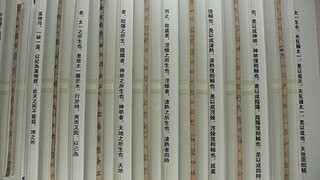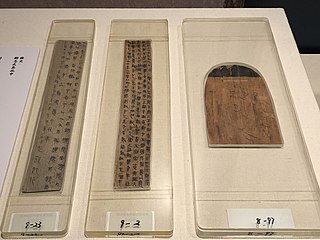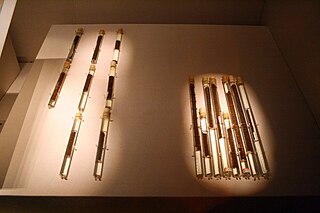 W
WThe bi is a type of circular ancient Chinese jade artifact. The earliest bi were produced in the Neolithic period, particularly by the Liangzhu culture. Later examples date mainly from the Shang, Zhou and Han dynasties. They were also made in glass.
 W
WA cong is a form of ancient Chinese jade artifact. It was later also used in ceramics.
 W
WThe "Five stars rise in the East" arm protector is an Eastern Han to Western Jin era brocade armband embroidered with the words "Five stars rise in the east, benefit China". Another cloth of the same pattern was found later and has the words "put down South Qiang" (討南羌). In 2002, they were designated one of the cultural relics that forbidden to be exhibited abroad.
 W
WThe Gouding (句町) Kingdom lasted approximately 400 years, from 111 BC to 316 AD, and was centered on Guangnan County in modern Wenshan Zhuang and Miao Autonomous Prefecture, Yunnan province, China.
 W
WThe Guodian Chu Slips were unearthed in 1993 in Tomb no. 1 of the Guodian tombs in Jingmen, Hubei Province and dated to the latter half of the Warring States period.
 W
WA jade burial suit is a ceremonial suit made of pieces of jade in which royal members in Han dynasty China were buried in.
 W
WThe Liye Qin Slips is a large collection of bamboo slips which were unearthed from Liye Ancient City in Longshan County, Hunan, China in 2002. It is one of China's most important archaeological discoveries of the 21st century. Archaeologists found more than 37,000 pieces of bamboo slips, on which more than 200,000 Chinese characters record government and legal documents of the Qin dynasty. It is considered the most important archaeological discovery of the Qin dynasty after the Terracotta Army unearthed in 1973 in Xi'an.
 W
WA pig dragon or zhūlóng is a type of jade artifact from the Hongshan culture of neolithic China. Pig dragons are zoomorphic forms with a pig-like head and elongated limbless body coiled around to the head and described as "suggestively fetal". Early pig dragons are thick and stubby, and later examples have more graceful, snakelike bodies.
 W
WThe Qin bronze chariot refers to a set of two Qin dynasty bronze model chariots that were unearthed in 1980 at the Mausoleum of the First Qin Emperor, Qin Shi Huang. When the models were found they were in many broken pieces, and it took five years to restore them both. Both models are about half life-size.
 W
WThe Sampul tapestry is an ancient woolen wall-hanging found at the Tarim Basin settlement of Sampul in Lop County, Hotan Prefecture, Xinjiang, China, close to ancient city of Khotan. The object has many Hellenistic period features, including a Greek centaur and diadem, linking it to the Greco-Bactrian Kingdom. It may represent a Yuezhi soldier, in red jacket and trousers, from the 1st century CE.
 W
WShuanggudui is an archeological site located near Fuyang in China's Anhui province. Shuanggudui grave no. 1, which belongs to Xiahou Zao (夏侯灶), the second marquis of Ruyin (汝陰侯), was sealed in 165 BCE in the early Han dynasty. Excavated in 1977, it was found to contain a large number of texts written on bamboo strips, including fragments of the Classic of Poetry and the Songs of the South, a text on breathing exercises, a "year table" (年表) recounting historical events, a manual on dogs, a version of the I Ching (Yijing) that differs from the received one, and artifacts including the oldest known cosmic board, a divinatory instrument. Like Mawangdui and Guodian, two other tombs from the area of the old state of Chu, the Shuanggudui find has shed great light on the culture and practices of the early Han dynasty.
 W
WThe Shuihudi Qin bamboo texts are early Chinese texts written on bamboo slips, and are also sometimes called the Yúnmèng Qin bamboo texts. They were excavated in December 1975 from Tomb #11 at Shuìhǔdì (睡虎地) in Yunmeng County, Hubei, China. The tomb belonged to a Qin administrator of c. 217 BCE.
 W
WThe Spear of Fuchai is the spear of King Fuchai of Wu, the archrival of King Goujian of Yue. It was unearthed in Jiangling, Hubei in November 1983. The script on it is bird-worm seal script, a variant of seal script that was commonly used in the southern states such as Wu and Yue. The inscription mirrors the text of King Goujian's Sword, except changing the name of the owner and type of weapon. In this case, the text reads, "吴王夫差自作用矛" or "King Fuchai of Wu made for his personal use, this spear."
 W
WThe Stone Drums of Qín or Qin Shi Gu are ten granite boulders bearing the oldest known "stone" inscriptions in ancient Chinese. Because these inscribed stones are shaped roughly like drums, they have been known as the Stone Drums of Qin since at least the 7th century.
 W
WThe three hares is a circular motif or meme appearing in sacred sites from the Middle and Far East to the churches of Devon, England, and historical synagogues in Europe. It is used as an architectural ornament, a religious symbol, and in other modern works of art or a logo for adornment, jewelry, and a coat of arms on an escutcheon. It is viewed as a puzzle, a topology problem or a visual challenge, and has been rendered as sculpture, drawing, and painting.
 W
WThe Yinqueshan Han Slips are ancient Chinese writing tablets from the Western Han Dynasty, made of bamboo strips and discovered in 1972. The tablets contain many writings that were not previously known or shed new light on the ancient versions of classic texts.